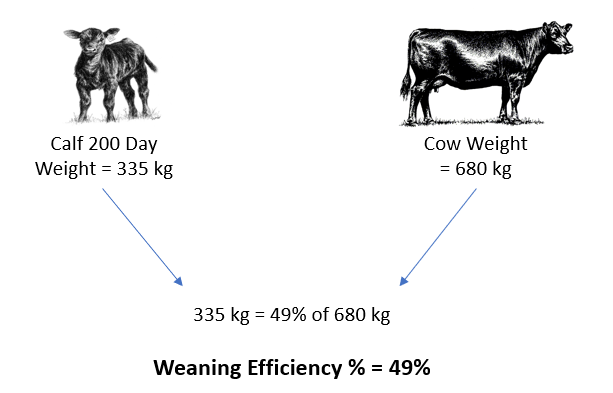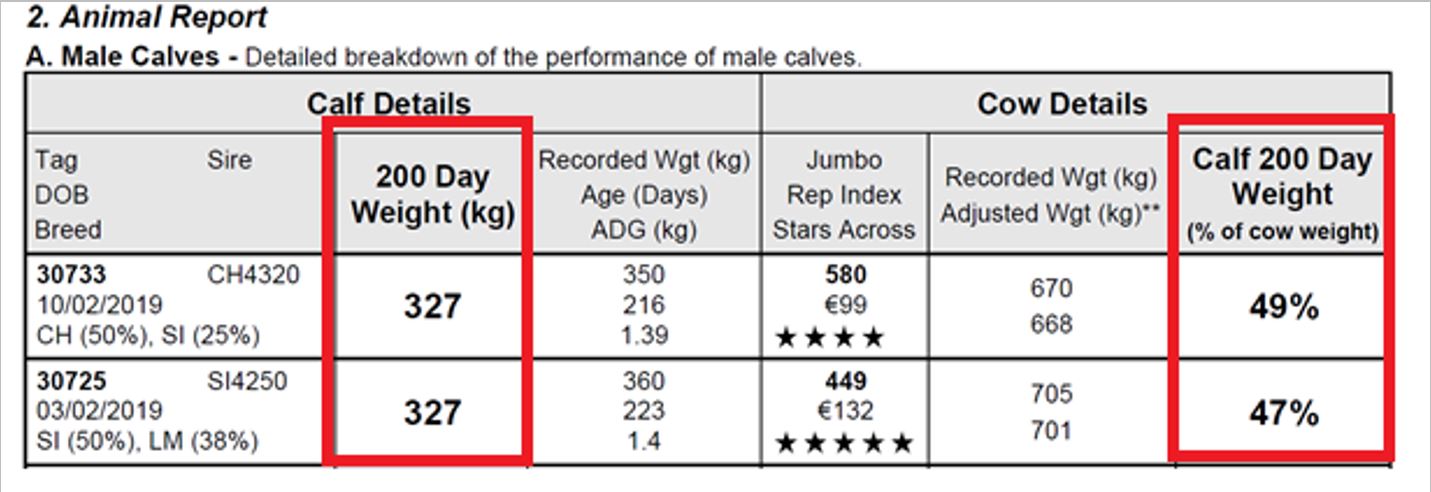ICBF has recently issued ‘Weaning Performance Reports’ to all herds that participated in the Beef Environmental Efficiency Pilot (BEEP) in 2019. Farmers weighed suckler calves and their dams and submitted the data to ICBF as part of the pilot. These reports have been generated on the back of this weight data.
What is a ‘Weaning Performance Report’
It is a new performance report for suckler farmers that are weight recording their cows and calves. The report calculates an adjusted 200-day weight for each calf and its dam and then expresses the calf 200-day weight as a % of the cow’s weight to give you a ‘Weaning Efficiency %’ (see figure 1).

Calf 200-day weight
Each calf’s weight is adjusted to 200 days of age so that the performance of all calves can be compared. An 8-month old calf will generally be heavier than a 5-month old calf on a given day, but the younger calf could have a higher average daily gain (ADG). The adjusted 200-day weight removes the effect of age and highlights the fastest growing animals.
Cow Weight
Each cow’s weight is adjusted to 200-days post-calving. Suckler cows will generally gain weight as they progress through a lactation. Like the calf weight, the cow weight is adjusted to remove the effect of the calving date and allows the weights of all cows to be compared.
Weaning Efficiency
This is a simple calculation which expresses the calf’s adjusted 200-day weight as a % of the cow’s adjusted 200-days post-calving weight (see figure 1). You should target a ‘Weaning Efficiency’ of at least 42%, That would mean that a 700kg cow should rear a calf to weight at least 294kg at 200 days old.
Reading the report
The first section of the report summarises the performance records of the cows and calves within the herd. It lists the top and bottom performing calves and cows as well as ranking the sires of the calves based on progeny performance.
The animal section of the report lists each calf that was weighed as well as its dam (see figure 2). The calf ‘200 Day Weight’ and ‘Weaning Efficiency %’ are the most relevant figures here.

In the example in figure 2, both calves have the same 200-day weight of 327kg and so are likely to make a similar sale price. This may not result in the same margin for the farmer due to the cost associated with the maintenance of the dam. Cows 580 and 449 are producing the same output but as 449 is over 30kg heavier, she is costing more to feed and is less efficient.
Analysis of BEEP data
The weight data collected as part of BEEP was analysed by Teagasc based on the Replacement Index of the cows and the results are very positive (see table 1). 5-star cows were the lightest, yet produced the heaviest calves at 200 days resulting in the highest ‘Weaning Efficiency %’.

Calf 200-day weight and weaning efficiency % are internationally recognised as key performance indicators for suckler beef herds.The Weaning Performance Report is intended as a management tool for suckler farmers which will identify the most efficient cows in the herd. Perhaps more importantly, the report also highlights the least efficient cows whose poor performance may require further investigation.
If you have any question on the Weaning Performance Report, please contact ICBF on 023-8820452 or email [email protected].
